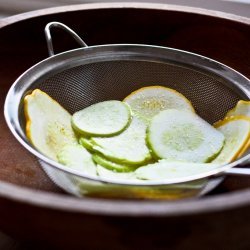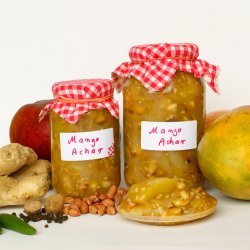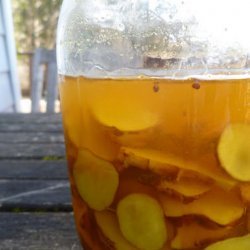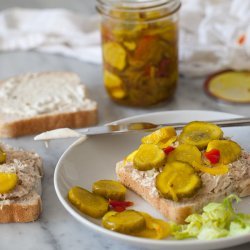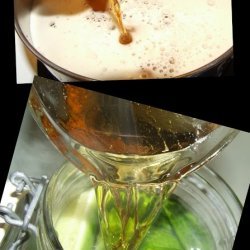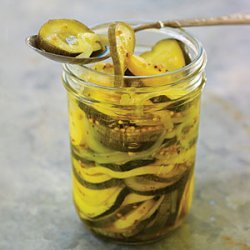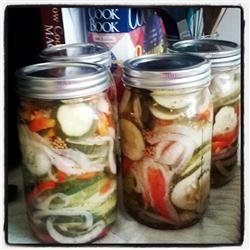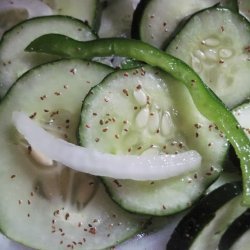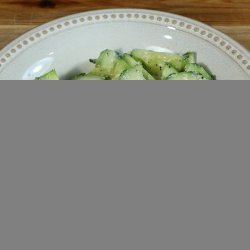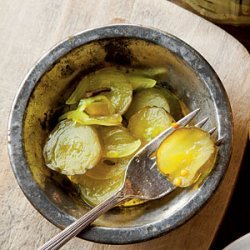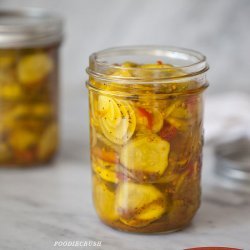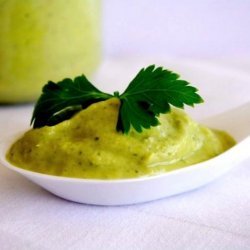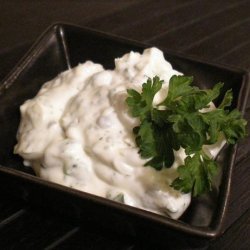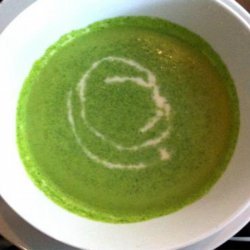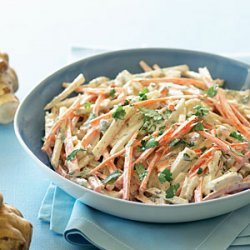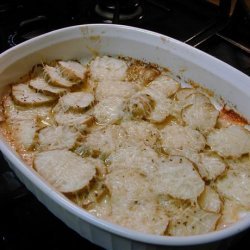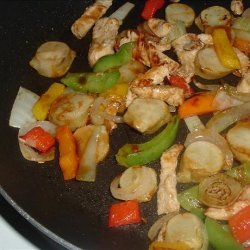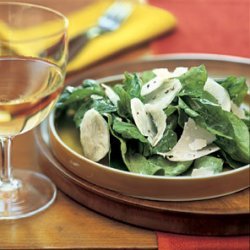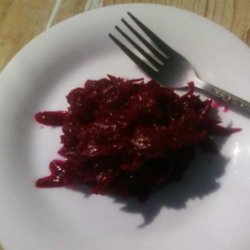Directions:
- You will need 2 large stainless steel pots or very large plastic bowls to soak the vegetables. They must be large enough to hold one gallon of water each, plus 6 pounds of vegetables (chopped) each. DO NOT use aluminum; the vinegar will react with it.
- First you have to clean the artichokes. They are pretty knobby, and they collect a lot of dirt and grit. Put the artichokes in a large pot and cover with water. Scrub each artichoke thoroughly with a stiff vegetable brush, and run it under some water. If grit seems to be trapped between the artichoke and its fingers , you may have to pop them off to get the grit out.
- Make a brine out of ONE of the cups of salt, one gallon of water, and the 4 tablespoons of white vinegar. Stir well to make sure all the salt is dissolved.
- Prepare the artichokes: do not peel the artichokes - the peel is edible and you will lose a lot of vitamins, plus these things are really knobby and if you try to peel 6 pounds of them I assure you you will lose your enthusiasm for making this relish.
- Chopping: you have two choices here. I prefer to cut the artichokes into quarter inch dice by hand. Other folks use a food processor. The reason I don't use a food processor is because Jerusalem artichokes have a unique consistency, and they don't chop well in the food processor. Some of them get pulverized, while large chunks remain unchopped. So, if you like, use a food processor, but just make sure you don't end up with mush. You want a lot of very small chunks; it should look about the consistency of relish. As you cut the artichokes, place them in the brine.
- Make a second batch of brine with the remaining cup of salt and one gallon water, stirring well to make sure all the salt dissolves.
- In a food processor, chop the cabbage, onions, and bell peppers until they are cut fine. Make sure to keep an eye on what you are doing so you don't get mush. You want the vegetables to be the consistency of a relish.
- Once they are chopped, place the vegetables in the second batch of brine you made, and stir well.
- Cover both bowls of brined vegetables, and leave on the counter overnight or for 8 hours. Don't let them sit in the brine for longer than 10 hours or the vegetables may become too salty.
- Line a counter with lots of paper towels - I usually use 5 layers. You are going to be placing the drained vegetables on these paper towels, so make sure you cover a fairly large space; at least 2 1/2 feet by 1 1/2 feet.
- Drain the Jerusalem artichokes and rinse with cold water. Drain well and place on half of the paper towels.
- Drain the cabbage/onion/pepper mixture and rinse with cold water. Drain well, and then with your hands, which you have just washed in hot water with soap, squeeze the remaining moisture out of the vegetables. You will see that a lot of water still comes out. Place the drained and squeezed vegetables on the other half of the paper towels.
- In a large bowl, whisk together the French's mustard and the flour. Set aside.
- In a very large stockpot (at least 10 quarts), combine the apple cider vinegar, white wine vinegar, sugar, yellow mustard seed, turmeric, celery seed, cayenne pepper, ground allspice, ground cloves, and black pepper.
- Bring to a boil, stirring well, and then reduce to a simmer.
- Dip out about 2 cups of the vinegar mixture and add it to the mustard/flour mixture in the bowl, whisking well to combine - make sure you whisk it until there are no more lumps.
- Add the mustard/flour mixture back to the vinegar mixture in the stockpot, whisking well to combine. Bring to a boil and then let simmer for 10 minutes over medium heat, whisking occasionally.
- Add the drained artichokes and the cabbage/onion/pepper mixture, and stir very well, making sure all is combined and mixed well with the vinegar/mustard mixture. Bring to a boil, stirring often.
- Place in canning jars, leaving 1/2 headspace. Use a chopstick or other thin, non-metal utensil to run around the sides of the jar to make sure there are no air bubbles left in the jar. Wipe the rims of the jars with damp paper towels to remove any relish which got on the rims or the threads. Place the lids and the bands on the jars, just tightening the bands fingertip tight.
- Process in a boiling water bath for 15 minutes, then remove and let sit, undisturbed, for at least 12 hours before checking seals. It is important to let them sit undisturbed for 12 hours because the sealing compound on the lids is still cooling and hardening, completing the seal. While the jars cool, you will hear a plink type sound from each jar - this is the jars completing the vacuum seal as the final air escapes the jar. After 12 hours have passed, remove the bands and check the lids - press down in the center of the lid. If you cannot push the lid down any further, the jar is sealed. If the lid gives a bit, and you can push it down, the jar did not seal. You can either put the band back on the jar, and reprocess it for another 15 minutes, or you can just put it in the fridge and use it within 3 months.
- Artichoke relish should sit for at least a month before you use it, so the flavors can combine and improve.
Nutrition Facts
| Amount Per 1 Serving | |||
| Calories | 748 Kcal (3132 kJ) | ||
| Calories from fat | 19.99 Kcal | ||
| % Daily Value* | |||
| Total Fat | 2.22g | 3% | |
|---|---|---|---|
| Sodium | 19229.71mg | 801% | |
| Potassium | 1411.15mg | 30% | |
| Total Carbs | 174.57g | 58% | |
| Sugars | 141.83g | 567% | |
| Dietary Fiber | 11.06g | 44% | |
| Protein | 7.72g | 15% | |
| Vitamin C | 115.6mg | 193% | |
| Vitamin A | 1.5mg | 49% | |
| Iron | 33.3mg | 185% | |
| Calcium | 155.9mg | 16% | |
| Amount Per 100 g | |||
| Calories | 86.23 Kcal (361 kJ) | ||
| Calories from fat | 2.31 Kcal | ||
| % Daily Value* | |||
| Total Fat | 0.26g | 3% | |
|---|---|---|---|
| Sodium | 2216.87mg | 801% | |
| Potassium | 162.68mg | 30% | |
| Total Carbs | 20.13g | 58% | |
| Sugars | 16.35g | 567% | |
| Dietary Fiber | 1.28g | 44% | |
| Protein | 0.89g | 15% | |
| Vitamin C | 13.3mg | 193% | |
| Vitamin A | 0.2mg | 49% | |
| Iron | 3.8mg | 185% | |
| Calcium | 18mg | 16% | |
* Percent Daily Values are based on a 2000 calorie diet. Your daily values may be higher or lower depending on your calorie needs.
Find out how many calories should you eat.
Get Your Recipe of Health!
Follow RecipeOfHealth on Facebook!


